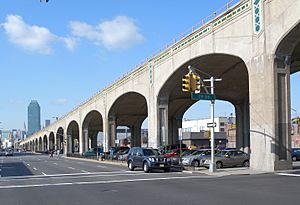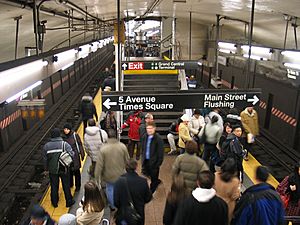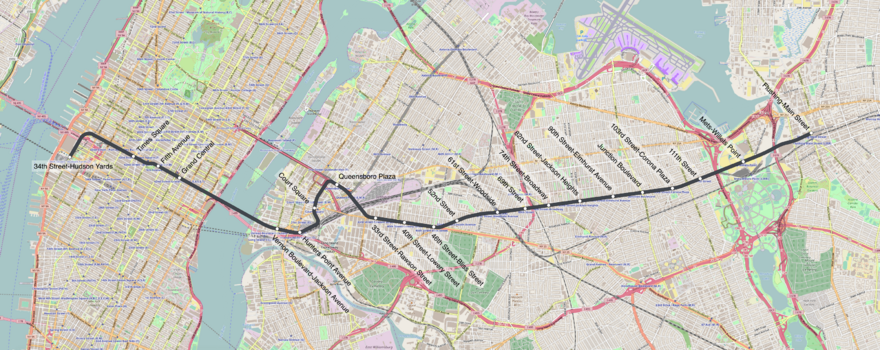IRT Flushing Line facts for kids
Quick facts for kids IRT Flushing Line |
|
|---|---|
 
The 7 and 7 Express, which use the Flushing Line through Midtown Manhattan, are colored purple.
|
|
| Overview | |
| Owner | City of New York |
| Termini | Flushing–Main Street 34th Street–Hudson Yards |
| Stations | 22 |
| Service | |
| Type | Rapid transit |
| System | New York City Subway |
| Operator(s) | New York City Transit Authority |
| Daily ridership | 425,688 |
| History | |
| Opened | 1915–1928 (between Times Square and Flushing–Main Street) September 13, 2015 (between 34th Street and Times Square) |
| Technical | |
| Number of tracks | 2–5 |
| Character | Underground (Manhattan, Western Queens and Main Street) Elevated (east of Hunters Point Avenue and west of Main Street, exclusive) |
| Track gauge | 4 ft 8 1⁄2 in (1,435 mm) |
| Electrification | 625 V DC third rail |
The IRT Flushing Line is a subway line in the New York City Subway system. It gets its name from its eastern end in Flushing, Queens. This line is part of the "A Division," which includes older, narrower subway lines. The Interborough Rapid Transit Company (IRT), a private company, built most of the line between 1915 and 1928. It originally ran from Flushing to Times Square in Manhattan.
In 2015, the line was extended west to Hudson Yards in Manhattan. Now, the Flushing Line goes all the way from Flushing to Chelsea, Manhattan. It carries the 7 local train and the <7> express train during busy times. This is the only IRT line that currently serves Queens.
The Flushing Line is shown in raspberry on subway maps and signs. Before it reached Flushing in 1928, it was sometimes called the Corona Line. For a while, the part between Times Square and Queensboro Plaza was known as the Queensboro Line. Since the mid-2010s, the line has been updated with a modern, automated signal system.
The Flushing Line has many different building styles. Some parts are elevated (above ground) with steel structures. Other parts are concrete bridges called viaducts. The underground stations also have unique designs. For example, Hunters Point Avenue station looks like an Italian building. Grand Central–42nd Street station is a round tunnel, similar to stations in London's subway. The 34th Street–Hudson Yards station is very deep and spacious, like stations in Washington D.C.'s Metro.
Contents
Exploring the Flushing Line
Subway services and route
The trains that use the Flushing Line are colored raspberry. Here's how the services run on the line:
| Train Service | When it runs | |
|---|---|---|
| During rush hours (busy times) |
Other times | |
| Runs along the whole line | ||
| Runs along the whole line | No service | |
The Flushing Line has two main parts, separated by the Queensboro Plaza station. It starts underground at Flushing–Main Street with three tracks. The middle track is for express trains. Soon after, the line goes above ground onto a steel structure over Roosevelt Avenue. It passes by Citi Field, where the Mets baseball team plays, and the United States Tennis Association's National Tennis Center. Near Mets–Willets Point station, there's a special track connection to the Corona Yard, where trains are stored and repaired.
At 48th Street in Sunnyside, the line moves over Queens Boulevard. Here, it becomes a fancy concrete bridge. The express track ends between 33rd Street–Rawson Street and Queensboro Plaza.
At Queensboro Plaza, the track going east is above the track going west. Both tracks are on the south side of the station platforms. On the north side of these platforms is the BMT Astoria Line. In the past, both the Flushing Line and the Astoria Line were used by two different subway companies, the IRT and the BMT. There are still connections between the tracks just east of the platforms. However, these connections cannot be used for regular train service. This is because BMT trains are wider than IRT trains. This is the only place where the Flushing Line connects to the rest of the subway system.
West of Queensboro Plaza, the line turns sharply south and goes over 23rd Street. It then enters the west end of Amtrak's Sunnyside Yard, which is a large train storage area. The line then goes underground through two stations before entering Manhattan. It crosses under the East River through the Steinway Tunnel. In Manhattan, the line runs under 42nd Street. Part of it is directly below the 42nd Street Shuttle (S train). Then it angles towards 41st Street. The Times Square–42nd Street station is directly under 41st Street. This station does not have track connections to other subway lines.
West of Times Square, the tracks curve down sharply and go under 11th Avenue. The tracks actually end at 24th Street, even though the last station is at 34th Street. This part of the line was built as an extension to Manhattan's Far West Side. New York City wanted to host the 2012 Summer Olympics. Even though London won the bid, the city still built the extension. This helped develop the far West Side as part of the Hudson Yards Redevelopment Project.
Special features of the line
The Flushing Line is one of only two subway lines in New York City that has just one train service. It does not share its tracks with any other subway line or service. The other line like this is the BMT Canarsie Line, which carries the L train. Because of this, the MTA (the subway operator) is making the Flushing Line automated. This means new trains use a system called communication-based train control (CBTC). This is similar to how the Canarsie Line works. CBTC helps trains run more smoothly and closer together.
The IRT Flushing Line's 7 train service uses the most subway cars in New York City. These 7 trains are eleven cars long! Most other subway services use ten or eight-car trains. However, the 7 trains are not the longest trains by total length. A train from the IND/BMT lines with ten 60-foot-long cars or eight 75-foot-long cars is 600 feet long. This is still 35 feet longer than an IRT train with eleven 51.4-foot-long cars, which is 565 feet long.
See also
 In Spanish: Línea Flushing para niños
In Spanish: Línea Flushing para niños




